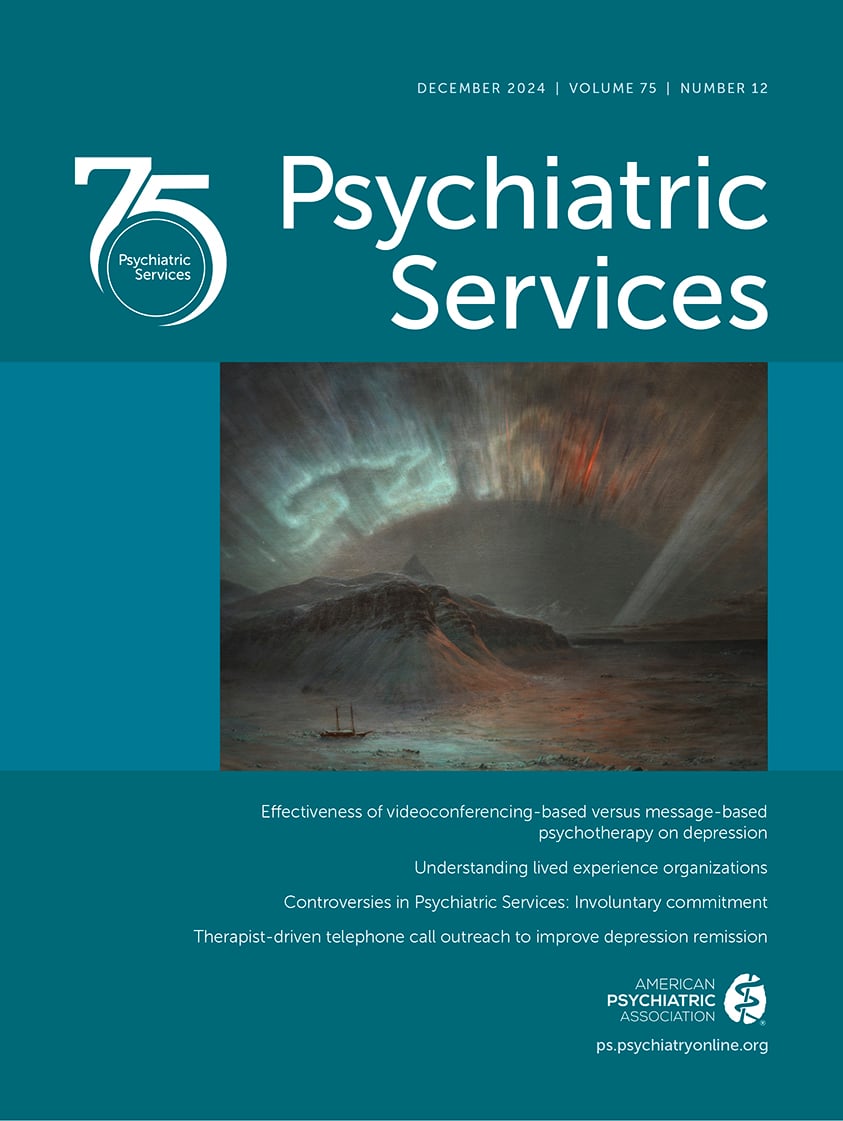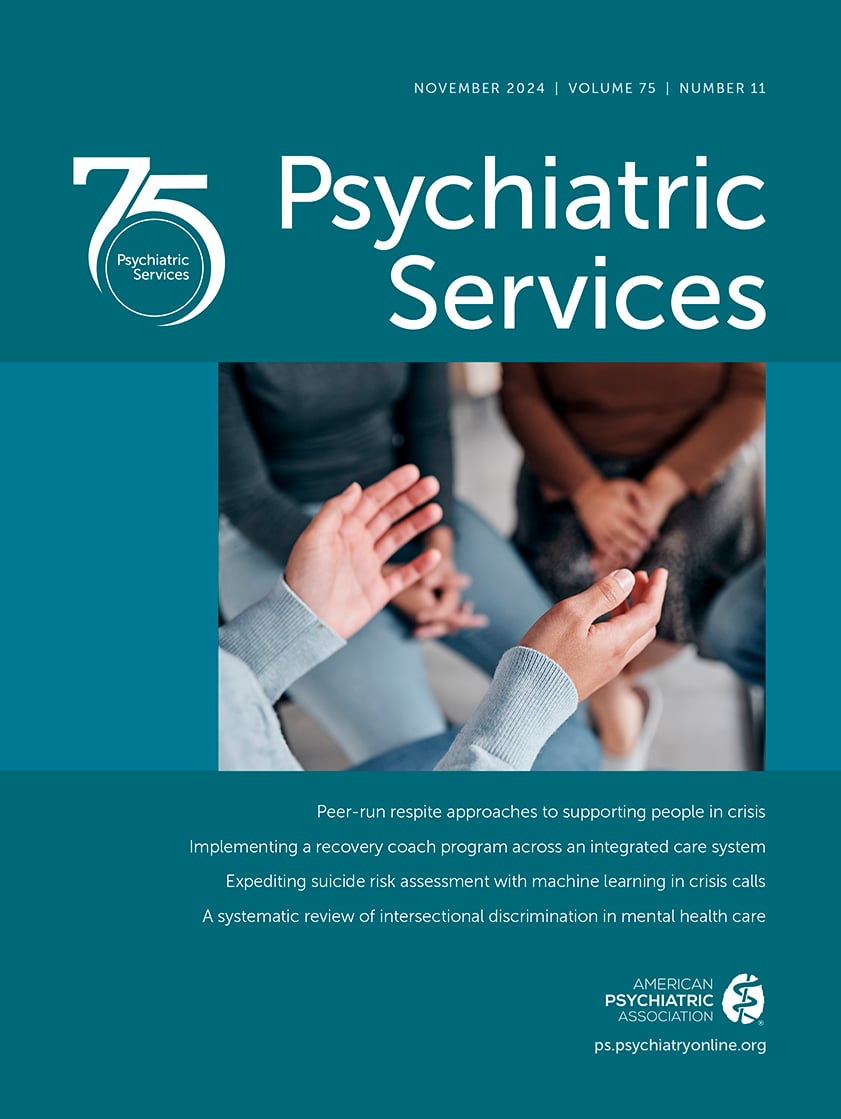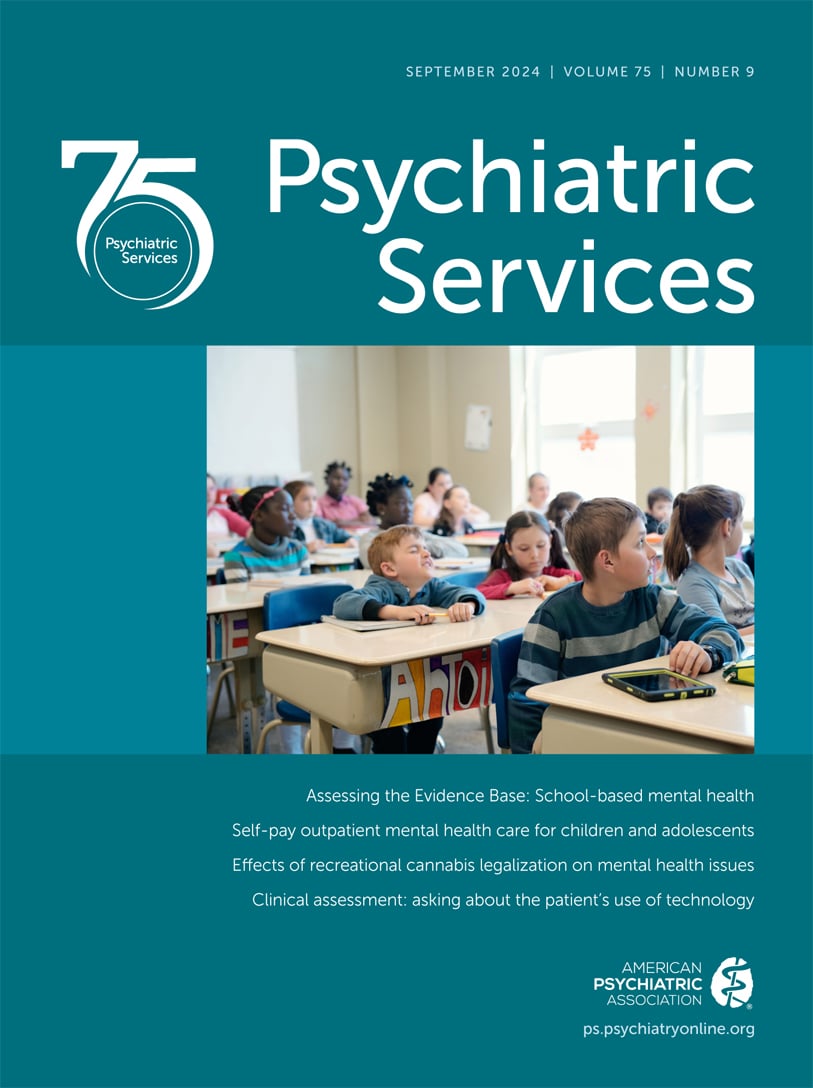Psychiatric Services
- Volume 69
- Number 6
- June 2018
Taking Issue
Reviews & Overviews
Publication date: 02 May 2018
Pages628–647Objective: The objective of this systematic review was to identify interventions to improve the initiation of mental health care among racial-ethnic minority groups. Methods: The authors searched three electronic databases in February 2016 and ...
https://doi.org/10.1176/appi.ps.201700382Articles
Publication date: 01 March 2018
Pages648–656Objective: This study aimed to understand the pathways to care from the onset of a first episode of psychosis to entry into a specialized early intervention service (EIS) for individuals with nonaffective psychosis. Methods: A sample of 20 individuals who ...
https://doi.org/10.1176/appi.ps.201700018Publication date: 15 March 2018
Pages657–663Objective: Evidence suggests that suicide attempts by self-inflicted gunshot wound (GSW) are underreported and may in turn affect disposition following hospitalization. This study aimed to evaluate the clinical characteristics and use of services among ...
https://doi.org/10.1176/appi.ps.201700130Publication date: 02 April 2018
Pages664–670Objective: The purpose of this study was to evaluate health outcomes of a state-supported implementation in community mental health settings of an evidence-based lifestyle intervention for overweight and obese adults with serious mental illness. Methods: ...
https://doi.org/10.1176/appi.ps.201700368Publication date: 02 April 2018
Pages671–676Objective: This study evaluated risk factors for utilization of acute care services (ACS) (hospitalization or emergency department or urgent care visit) for lithium toxicity and the prevalence of lithium toxicity in a large, ambulatory population. Methods: A ...
https://doi.org/10.1176/appi.ps.201700346Publication date: 15 February 2018
Pages677–684Objective: Mitigation of suicide risk by reducing access to lethal means, such as firearms and potentially lethal medications, is a highly recommended practice. To better understand groups of patients at risk of suicide in medical settings, the authors ...
https://doi.org/10.1176/appi.ps.201700237Publication date: 01 March 2018
Pages685–688Objective: Despite the critical role behavioral health care payers can play in creating an incentive to use evidence-based practices (EBPs), little research has examined which incentives are used in public mental health systems, the largest providers of ...
https://doi.org/10.1176/appi.ps.201700508Publication date: 02 April 2018
Pages689–695Objective: Although screening for psychosis may reduce the duration of untreated psychosis, the barriers and facilitators associated with implementing such a procedure in various care settings have not been explored. Methods: Investigators conducted in-depth,...
https://doi.org/10.1176/appi.ps.201700392Publication date: 15 March 2018
Pages696–702Objectives: The Veterans Health Administration (VHA) has achieved substantial national implementation of primary care–mental health integration (PC-MHI) services. However, little is known regarding program characteristics, variation in characteristics ...
https://doi.org/10.1176/appi.ps.201700213Publication date: 01 March 2018
Pages703–709Objective: The purpose of this study was to examine variability in outcomes (suicide attempt rates) across subgroups of patients who were randomly enrolled in brief cognitive-behavioral therapy (CBT) and treatment as usual. Methods: A secondary analysis was ...
https://doi.org/10.1176/appi.ps.201700452Publication date: 15 March 2018
Pages710–713Objective: This analysis quantified and assessed the projected workforce of psychiatrists in the United States through 2050 on the basis of population data. Methods: With use of data from the Association of American Medical Colleges (2000–2015), American ...
https://doi.org/10.1176/appi.ps.201700344Publication date: 15 March 2018
Pages716–722Objective: The study examined differences in psychotropic polypharmacy among youths with serious emotional and behavioral disorders who received coordinated care services (CCS) that used a wraparound model and a matched sample of youths who received ...
https://doi.org/10.1176/appi.ps.201700357Open Forum
Publication date: 01 March 2018
Pages723–725This Open Forum explores the role of implicit bias along the mental health care continuum, which may contribute to mental health disparities among vulnerable populations. Emerging research shows that implicit bias is prevalent among service providers. ...
https://doi.org/10.1176/appi.ps.201700294Publication date: 15 February 2018
Pages726–728Extensive evidence documents that people with severe mental illness have higher rates of morbidity and mortality compared with the general population and receive lower-quality and higher-cost health care. These trends, at least in part, stem from ...
https://doi.org/10.1176/appi.ps.201700138Technology in Mental Health
Publication date: 01 March 2018
Pages618–619Safety planning is an emerging evidence-based practice that is effective at decreasing suicidal behaviors. As electronic medical records and patient portals become more prevalent, patients and clinicians have recognized the value of using this technology ...
https://doi.org/10.1176/appi.ps.201700458Global Mental Health Reforms
Publication date: 15 March 2018
Pages620–622In 2010, the Regional Council of the Capital Region of Denmark endorsed a vision of mental health services based on personal recovery, rehabilitation, and the involvement of caregivers. Programs to achieve this vision include hiring peer support workers, ...
https://doi.org/10.1176/appi.ps.201800019Promoting High-Value Mental Health Care
Publication date: 01 March 2018
Pages623–625The authors describe a quality improvement approach in which a crisis center and a payer collaborate to improve care. Each crisis visit is considered as a potentially missed opportunity for community stabilization. Daily data on crisis visits are sent to ...
https://doi.org/10.1176/appi.ps.201700533Viewpoint
Commentary
Frontline Reports
Brief Reports
Publication date: 26 April 2018
Pages729–732Objective: The study examined whether the number of outpatient addiction programs accepting Medicaid in South Carolina counties is linked to repeat use of the emergency department for addiction-related conditions. Methods: The study included the population ...
https://doi.org/10.1176/appi.ps.201700413Past Issues
View Issues Archive
Vol. 75 | No. 12

Vol. 75 | No. 11

Vol. 75 | No. 10
